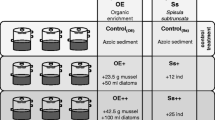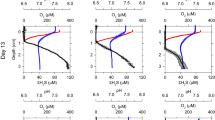Abstract
The effects of differences in the level of oxygenation of sediment or water on the condition and copper content of two bivalves, the Baltic clam Macoma balthica and the cockle Cerastoderma edule, were assessed. Specimens from four intertidal flats in the Netherlands and France were compared, translocated and exposed to different levels of oxygen in the laboratory. Cockles showed no significant differences in condition and copper content between animals from light (= more oxygenated) and dark (= less oxygenated) sediments. Baltic clams also showed no differences in condition, but the clams had a higher copper content (concentration as well as body burden) in dark than in light sediments. During the translocation experiments no significant changes occurred. In the laboratory experiments the level of oxygen had no effect on the condition or copper content of the Baltic clam. The only factor affecting the copper content of Baltic clams was the addition of copper to the water or sediment. The copper, organic carbon and silt fraction (< 16 µm) was higher in dark sediments than in light sediments. The copper content in the sediment was positively related to the silt and organic carbon content. We argue that the relation between coloration (= degree of oxygenation) of sediments and the copper content of Baltic clams could be indirect: due to a higher silt fraction and/or organic content at some places on a tidal flat, these places are more hypoxic and therefore darker, whereas simultaneously these places have a higher copper concentration because of more copper-complexing sites (and surface), whereby the higher copper concentration in the sediment relates to a higher copper concentration in the clams.
Similar content being viewed by others
References
Absil, M. C. P., 1993. Bioavailability of heavy metals for the deposit feeder Macoma balthica with special emphasis on copper. Ph.D. thesis, Agricultural University Wageningen, 171 pp.
Absil, M. C. P., M. Berntssen & L. J. A. Gerringa, 1996. The influence of sediment, food and organic ligands on the uptake of copper by sediment-dwelling bivalves. Aquat. Toxicol. 34: 13–29.
Amiard, J. C., C. Amiard-Triquet, B. Berthet & C. Metayer, 1987. Comparative study of the patterns of bioaccumulation of essential (Cu, Zn) and non-essential (Cd, Pb) trace metals in various estuarine and coastal organisms. J. exp. mar. Biol. Ecol. 106: 73–89.
Ankley, G. T., N. A. Thomas, D.M. Di Toro, D. J. Hansen, J. D. Mahony, W. J. Berry, R. C. Swartz, R. A. Hoke, A. W. Garrison, H. E. Allen & C. S. Zarba, 1994. Assessing potential bioavailability of metals in sediments: A proposed approach. Envir. Mgmt 18: 331–337.
Beukema, J. J. & W. de Bruin, 1977. Seasonal changes in dry weight and chemical composition of the soft parts of the tellinid bivalve Macoma balthica in the Dutch Wadden Sea. Neth. J. Sea Res. 11: 42–55.
Bryan, G. W., 1980. Recent trends in research on heavy-metal contamination in the sea. Helgol. Meeresunters. 33: 6–25.
Bryan, G. W., 1984. Pollution due to heavy metals and their compounds. In O. Kinne (ed.), Marine Ecology, Vol. 5, Part 3. John Wiley & Sons Ltd, Chichester: 1289–1431.
Bryan, G. W. & L. G. Hummerstone, 1977. Indicators of heavymetal contamination in the Looe estuary (Cornwall) with particular regard to silver and lead. J. mar. biol. Ass. U.K. 57: 75–92.
Bryan, G.W. W. J. Langston, 1992. Bioavailability, accumulation and effects of heavy metals in sediments with special reference to United Kingdom estuaries: a review. Envir. Poll. 76: 89–131.
Cain, D. J. & S. N. Luoma, 1990. Influence of seasonal growth, age and environmental exposure on Cu and Ag in a bivalve indicator, Macoma balthica, in San Francisco Bay. Mar. Ecol. Prog. Ser. 60: 45–55.
Coquery, M. & M. Horvat, 1996. The analytical performance study for the MED POL area: determination of trace elements in marine sediment SD-MED POL-1/TM and in fish homogenate MA-MED POL-1/TM. Intern. Atom. Energy Agency, 85 pp.
Di Toro, D. M., J. D. Mahony, D. J. Hansen, K. J. Scott, A. R. Carlson & G. T. Ankley, 1992. Acid volatile sulfide predicts the acute toxicity of cadmium and nickel in sediments. Envir. Sci. Technol. 26: 96–101.
Flemming, C. A. & J. T. Trevors, 1989. Copper toxicity and chemistry in the environment: a review. Wat. Air Soil Pollut. 44: 143–158.
Förstner, U., 1987. Sediment-associated contaminants - an overview of scientific bases for developing remedial options. Hydrobiologia 149: 221–246.
Förstner, U., 1990. Inorganic sediment chemistry and elemental speciation. In R. Baudo, J. P. Giesy & H. Muntau (eds), Sediments: Chemistry and Toxicity of in-place Pollutants. Lewis Publishers Inc., Ann Arbor: 61–105.
Gerringa, L. J. A., 1990. Aerobic degradation of organic matter and the mobility of Cu, Cd, Ni, Pb, Zn, Fe and Mn in marine sediment slurries. Mar. Chem. 29: 355–374.
Gerringa, L. J. A., 1991. Mobility of Cu, Cd, Ni, Pb, Zn, Fe and Mn in marine sediment slurries under anaerobic conditions and at 20% air saturation. Neth. J. Sea Res. 27: 145–156.
Hummel, H., R. Modderman, C. Amiard-Triquet, F. Rainglet, Y. van Duijn, M. Herssevoort, J. de Jong, R. Bogaards, G. Bachelet, M. Desprez, J. Marchand, B. Sylvand, J.-C. Amiard, H. Rybarczyk & L. de Wolf, 1997. A comparative study on the relation between copper and condition in marine bivalves and the relation with copper in the sediment. Aquat. Toxicol. 38: 165–181.
Kramer, C. J. M., 1986. Apparent copper complexation capacity and conditional stability constants in North Atlantic waters. Mar. Chem. 18: 335–349.
Langston, W. J. & M. Zhou, 1987. Cadmium accumulation, distribution and elimination in the bivalve Macoma balthica: Neither metallothionein nor metallothionein-like proteins are involved. Mar. Envir. Res. 21: 225–237.
Luoma, S. N., 1983. Bioavailability of trace metals to aquatic organisms - a review. Sc. Total Envir. 28: 1–22.
Luoma, S. N., 1989. Can we determine the biological availability of sediment-bound trace elements? Hydrobiologia 176: 379–398.
Luoma, S. N. & G. W. Bryan, 1982. A statistical study of environmental factors controlling concentrations of heavy metals in the burrowing bivalve Scrobicularia plana and the polychaete Nereis diversicolor. Estuar. coast. Shelf Sci. 15: 95–108.
Luoma, S. N., D. Cain & C. Johansson, 1985. Temporal fluctuations of silver, copper and zinc in the bivalve Macoma balthica at five stations in South San Francisco Bay. Hydrobiologia 129: 109–120.
McLusky, D. S., V. Bryant & R. Campbell, 1986. The effects of temperature and salinity on the toxicity of heavy metals to marine and estuarine invertebrates. Oceanogr. Mar. Biol. Ann. Rev. 24: 481–520.
Millward, G. E., 1995. Processes affecting trace element speciation in estuaries. A review. Analyst 120: 609–614.
Neuhoff, H. G., 1983. Synergistic physiological effects of low copper and various oxygen concentrations on Macoma balthica. Mar. Biol. 77: 39–48.
Nieuwenhuize, J., C. H. Poley-Vos, A. Goud & M. A. Hemminga, 1988. Determination of Cd, Cu, Pb and Zn in small marine insect larvae with a microdigestion method. Atomic Spectroscopy 9: 204–206.
Nieuwenhuize, J. & C. H. Poley-Vos, 1989. A rapid microwave dissolution method for the determination of trace and minor elements in lyophilized plant material. Atomic Spectroscopy 10: 148–153.
Nieuwenhuize, J., C. H. Poley-Vos, A. H. van den Akker & W. van Delft, 1991. Comparison of microwave and conventional extraction techniques for the determination of metals in soil, sediment and sludge samples by atomic spectrometry. Analyst 116: 347–351.
Sokal, R. R. & F. J. Rohlf, 1995. Biometry. Freeman & Company, New York, 887 pp.
Theede, H., 1985. Some problems of pollution with heavy metals under the environmental conditions of the Baltic Sea. Symp. Biol. Hung. 29: 223–238.
Westerlund, S. F. G., L. G. Anderson, P. O. J. Hall, A. Iverfeldt, M. M. Rutgers van der Loeff & B. Sundby, 1986. Benthic fluxes of cadmium, copper, nickel, zinc and lead in the coastal environment. Geochim. Cosmochim. Acta 50: 1289–1296.
Rights and permissions
About this article
Cite this article
Hummel, H., Magni, P., Amiard-Triquet, C. et al. Influence of the level of oxygenation in sediment and water on copper bioavailability to marine bivalves: laboratory experiments and translocation experiments in the field. Hydrobiologia 373, 297–310 (1998). https://doi.org/10.1023/A:1017015504106
Issue Date:
DOI: https://doi.org/10.1023/A:1017015504106




